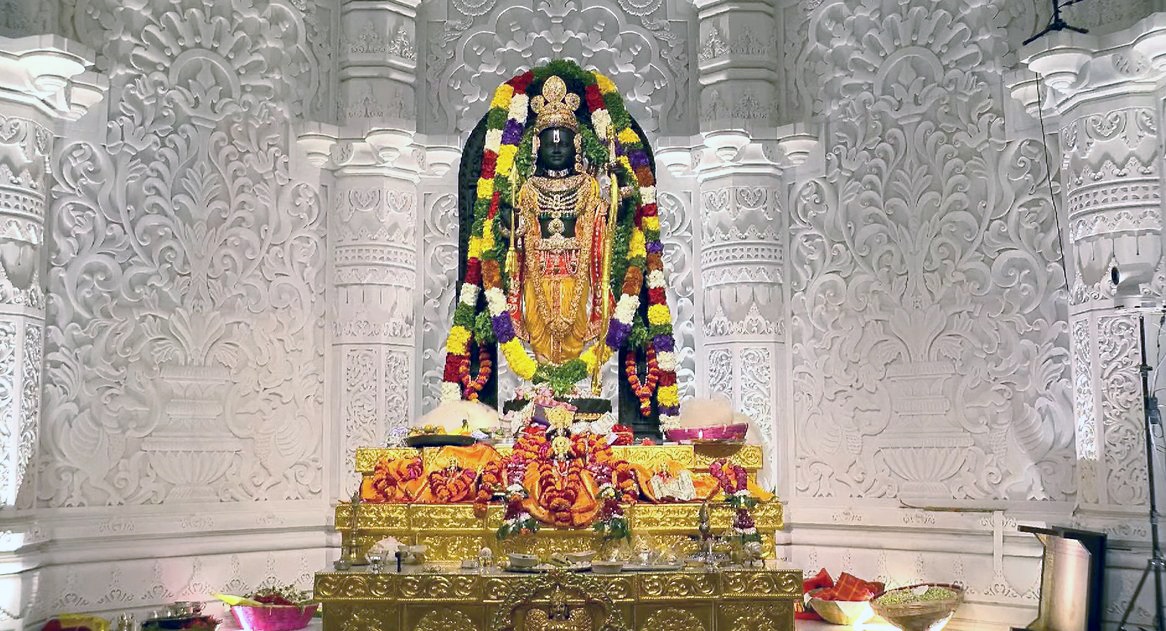With centuries of spirituality and history, the city of Ayodhya just saw the opening of the magnificent Ram Temple on January 22, 2024, a historic occasion. This imposing building, which embodies the commitment and architectural genius, is significant both culturally and religiously. Prime Minister Narendra Modi performed the Pran Prathishtha of Ram Lalla idol inside the Ram Mandir.
The historic Ram Mandir is made at a spot which is believed to be the Janambhoomi of Lord Ram, an incarnation of Lord Vishnu and main protagonist of Ramayana written by Valmiki and later Tulsidas. This article delves into the specifics of the Ram Temple, examining its architectural style, historical context, and the remarkable opening event.
Also read: How To Reach Ayodhya From Delhi By Air, Rail And Road
Ram Mandir: Historical Background
Ayodhya has played a significant role in Hindu mythology and history since it is thought to be the birthplace of Lord Rama. The Ayodhya controversy, a multi-decade legal and political drama, is deeply ingrained in the temple’s history. The Ram Temple is being rebuilt on the controversial site of Babri Mosque, which was built in 1500s by Babur’s henchman Mir Baqi.
For millions of devotees who have long longed to see the rebirth of this holy site, the construction of the Ram Temple is the realisation of a long-held desire. The verdict of Supreme Court in the favour of Ram Janambhoomi trust, after years of legal battle, led the path to the making of the grand temple in Ayodhya.
Devotees’ hearts were filled with joy and fulfilment when the conflict was resolved and the Ram Temple was built. PM Modi laid the foundation stone of the temple in 2020 and inaugurated the phase 1 of the temple in 2024, performing the Pran Prathishtha of the Ram Lalla idol. The entire structure of the temple will be built in the coming months.

Ram Mandir: Marvellous Architecture
A beautiful architectural work of art, the Ram Temple exhibits a tasteful fusion of traditional and modern design features. The Nagara architectural style, which is distinguished by its tall spires and elaborate carvings, served as inspiration for the temple’s design.
The building is a large complex with several mandapas, or pavilions, that are decorated with elaborate sculptures that represent scenes from the Ramayana. A marvel to behold is the centre sanctuary, which houses the idol of Lord Rama. The idol in beautiful black stone is built by Arun Yogiraj, a master sculptor from South India.
The sanctum’s design features elaborate details that highlight the artistry and talent of the craftspeople who created it. Several other shrines honouring Hanuman, the devoted follower of Lord Rama, and Sita, his bride, are also located within the temple complex.
Also read: Ayodhya Goes Green! Uber Electric Auto Service
The building is an architectural marvel that arouses the senses because of the use of pink sandstone, which gives the whole thing a warm and welcoming tone. The main temple building, which is 360 ft long, 235 ft wide and 161 ft high, is made of sandstone quarried from Bansi Pahadpur, Rajasthan.
Cement or iron and steel is not used anywhere in its construction. The Structural Design of the 3-storey temple is designed earthquake resilient and can withstand strong tremors of magnitude 8 on the Richter scale for as long as 2,500 years.
Shri Ram Mandir construction has been technically assisted by atleast four leading National Institutes of CSIR (Council of Scientific & Industrial Research) and DST (Department of Science & Technology) under Ministry of Science & Technology, in addition to certain inputs from other institutions like IITs as well as ISRO (Indian Space Research Organisation).
अयोध्या धाम में श्री राम लला की प्राण-प्रतिष्ठा का अलौकिक क्षण हर किसी को भाव-विभोर करने वाला है। इस दिव्य कार्यक्रम का हिस्सा बनना मेरा परम सौभाग्य है। जय सियाराम! https://t.co/GAuJXuB63A
— Narendra Modi (@narendramodi) January 22, 2024
Ram Mandir: Opening Ceremony
For millions of followers worldwide, the opening of the Ram Temple was an unmatched time of pleasure and celebration. On January 22, 2024, there were religious rites, cultural presentations, and the presence of well-known religious and political leaders at the occasion.
The first light of morning, signifying the start of a new age, illuminated the enormous temple, creating an atmosphere imbued with devotion. Traditional Vedic rites, such as songs being chanted and prayers being offered, kicked off the event. PM Modi himself performed all the rituals inside the temple.
The timing of Pran Prathishtha was 12.29 PM on January 22 and with this, the magnificent life sized idol was revealed to the world, in all its glory. With this, the temple is been thrown open to the general public, although, only VVIPs who were invited for the ceremony can see Ram Lalla on January 22.
Ram Mandir: In Summary
The Ram Temple at Ayodhya is an enduring symbol of the people’s rich cultural heritage and unwavering faith in God. The narrative that unfolds from the Ayodhya conflict to the historic inauguration showcases the tenacity of the Hindu’s spirit and the influence of belief.
Future generations will be inspired by the architectural wonder of the Ram Temple, which has a spiritual meaning and an exquisite design. The people who witnessed the historic occasion will always remember the inaugural ceremony as a display of devotion and solidarity.
As the Ram Temple develops into a popular tourist destination, it not only represents the spiritual core of Ayodhya but also acts as a global symbol of harmony and optimism.